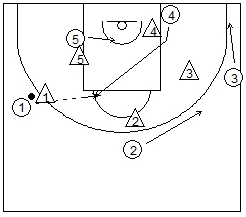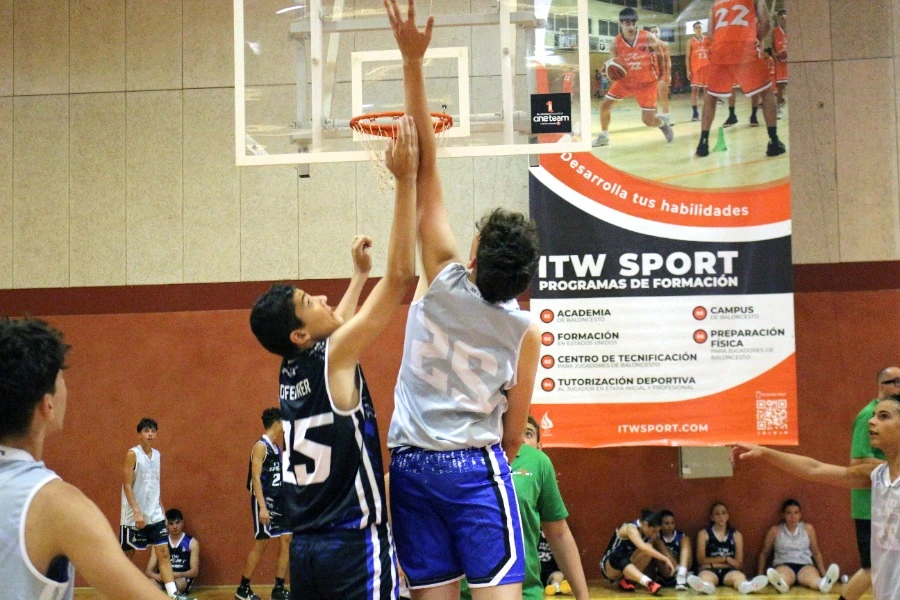Although the low-post game is no longer as prevalent, it is a fundamental game strategy in our team's offense. It should be developed at specific moments that we will address throughout the article.
Other competitive strategies
It is important to highlight that the offensive game in the low post is not an attack that should only be worked with the interior players, as we will see below, all other players will be involved.
Lastly, it should be added that in these types of plays in the low post in basketball, it is not necessary to master an endless number of movements, but executing one or two main moves effectively will be enough to create the imbalance we are looking for.
Fundamental Aspects for Playing Offense in the Low Post in Basketball
The technical aspects to consider when executing an offense in the low post are:
Passing ability
There are certain guidelines to consider regarding passing when making offensive plays in the low post:
- Pass from the outside to the low post at the right moment.
- Play inside-out: ability to pass from the player positioned in the low post.
- If the defender of the low post player is not making contact with them, the pass should be quick and straight so they don’t have a chance to intercept it.
- If the defender of the low post player is making contact with them, the pass should be bounced.
- After an indirect screen for the interior player, the pass should be quick and straight so the defender doesn’t have time to make contact.
Spacing
Players without the ball must create proper spacing. This will help give fluidity to the play, reduce the density of players in the paint, and ease the tension in the three-second area.
Low post players, the key
The central player of this play (the one in the low post) must:
- Make a pause when receiving the ball.
- Protect the ball with the chest and look to control defensive reactions.
- Dribble towards the center and, when receiving defensive help, dribble towards the baseline to expand the space the defense must cover.
Examples of offensive plays in the low post
Use scouting to decide which technique to apply.
- If there is no defensive help, play 1v1 but with good spacing from the remaining players: 3 outside players and 1 interior player positioned at the baseline, right behind the backboard, to cut along the baseline when the ball handler drives towards the center of the paint. This interior player without the ball must crash the offensive rebound. Player 3 should occupy the corner and player 2, the extension of the free-throw line (45º).

- When the ball handler plays the 1v1 towards the baseline (mostly because defensive help has occurred), the other interior player must occupy the center of the paint. The off-ball interior player should attack the offensive rebound. Player 3 should occupy the corner and player 2, the extension of the free-throw line (45º).

- Another option for the interior player with the ball when receiving defensive help is to make a return pass to the outside player (inside-out) to then take advantage of the defense's relaxation and regain position (“repost”). Now the defense makes contact, so the pass must be bounced, and the low post player must perform an outside pivot to finish, as they are very close to the basket.
- When the ball is positioned at the top of the key and the defender of the interior player is positioned behind, a direct pass to the interior player should be made. For this, the interior player must have both feet facing the ball, that is, with their back to the defender.

- When the ball is positioned at the top of the key and the defender of the interior player is defending in a three-quarter position, a pass should be made to the outside player so that they can make the final pass to the interior player (triangulation).

To perform a reverse in the low post, it is key to keep the center of gravity low.
It is also important to consider the concept of playing the 1v1 with the intention of passing.
- When the defense traps the ball handler in the low post, they must look for a pass out to take advantage of the created opportunities, and if there is no open shot from the receiving player, they should look for an extra pass, punishing the defensive rotation. It is important to note that immediately after the interior player receives the trap and passes the ball to an outside player, they should already be crashing the offensive rebound.

- Another option for the interior player when receiving a trap is a pass to the cutting outside players, either from the strong side or the weak side. The other players must move without the ball to create the proper spacing.


- When the ball is positioned at the extension of the free-throw line (45º) but the interior defender prevents their player from receiving the ball, the interior player on the weak side must occupy the high post to receive the ball and create a play, either with a pass to the low post ("hi-lo"), a finish of their own, or a pass to an outside player, who must collaborate by moving without the ball, creating proper spacing.

I hope these examples of offensive plays in the low post help you develop more effective strategies as a coach or player.
Juanjo Segura
Head Coach, ITW Sport Sports Program
Director of the digital magazine, www.entrenandobasket.es






